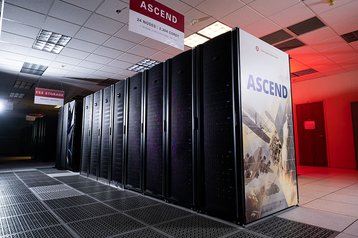The Ohio Supercomputer Center (OSC) has launched a new high-performance computing (HPC) GPU cluster.
Named ‘Ascend’, the Dell-based HPC cluster will be used for artificial intelligence, data analytics, and machine learning.
First announced in April 2022, Ascend comprises of Dell PowerEdge servers, 48 AMD EPYC CPUs, and 96 Nvidia A100 80GB Tensor Core GPUs with Nvidia NVLink, and connected by the NVIDIA Quantum 200 Gbps InfiniBand platform. With just 24 compute nodes, Ascend is smaller than the current clusters at OSC, but its performance remains on par.
Overall, the new cluster should add ~2 petaflops of peak performance to the OSC, and will triple the center’s capacity for AI, modeling, and simulation. Ascend will complement the OSC’s existing Pitzer and Owens clusters, bringing the total to 5.5 petaflops, 20 petabytes of storage, and 23 petabytes of expandable backup storage, and will be the center's first dedicated GPU platform.
“OSC developed Ascend in response to discussions with our client community, stakeholders and vendors, who identified an immediate need for greater GPU resources to process research and simulations that rely on AI, big data, and machine learning,” said David Hudak, executive director of OSC.
Doug Johnson, OSC associate director, noted that there are many clients and scientific applications that need a GPU like Ascend for their research.
“For some applications, there is a large performance benefit for using the GPUs and Ascend will make it possible for our clients to tackle some problems that can’t be solved on our current systems," he said.
Ascend was tested from October to December 2022 in order to get feedback from users on its performance. According to Johnson, the OSC intends to keep updating and improving the system as they learn more from users.
So far, however, the feedback looks good. Yu Su, an associate professor in the Department of Computer Science and Engineering at Ohio State University claims that her students have reported ‘double to triple the speed of processing’ compared to the A6000 GPU servers they were previously using.
Established in 1987 and based at the Ohio State University campus outside Columbus, the OSC is a statewide resource providing high-performance computing (HPC) services and expertise to Ohio university researchers and Ohio industries.
The OSC is reportedly also looking to replace its Owens cluster, now seven years old, which is expected to launch in 2023 though will temporarily run concurrently with Owens before its retirement, alongside Pitzer and Ascend.

